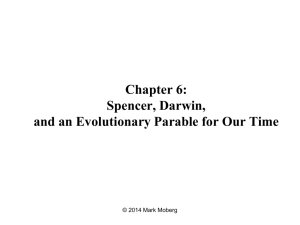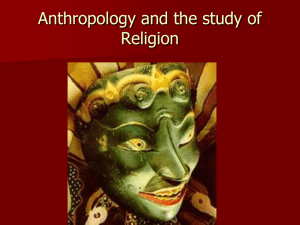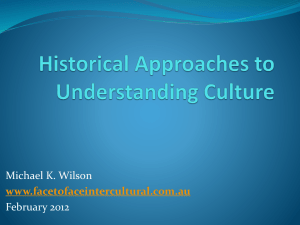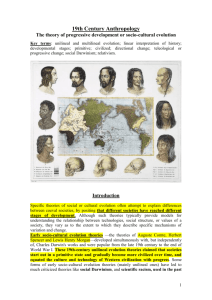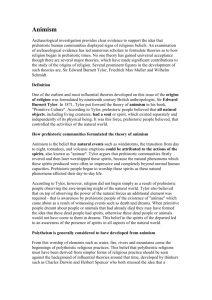Edward Burnett Tylor
advertisement
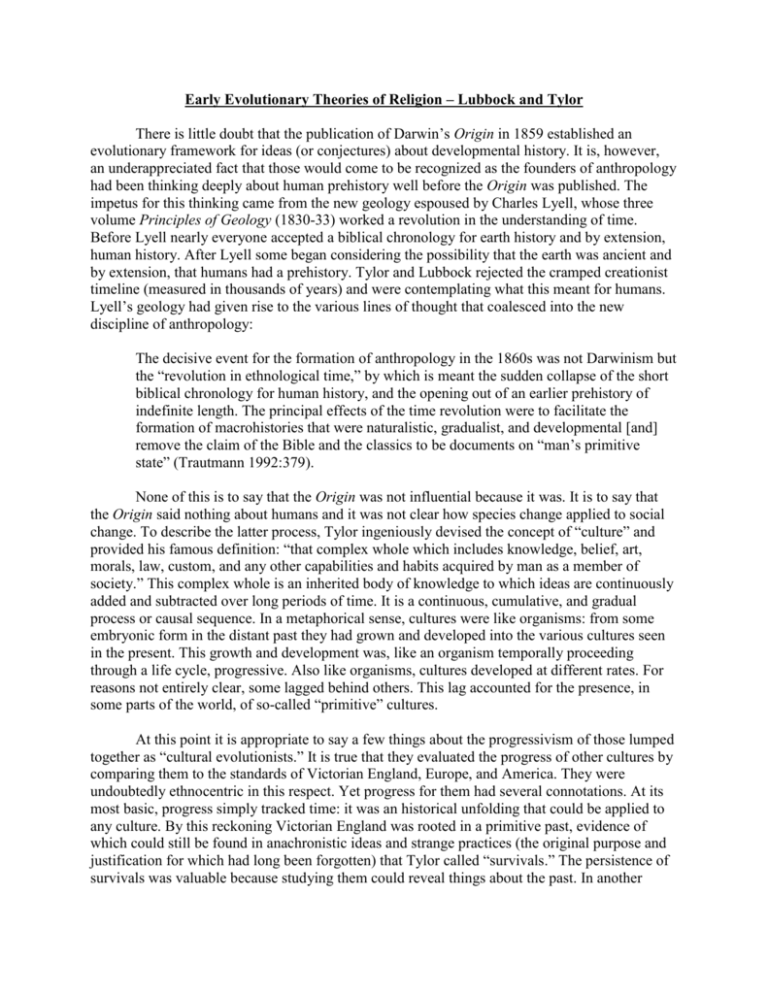
Early Evolutionary Theories of Religion – Lubbock and Tylor There is little doubt that the publication of Darwin’s Origin in 1859 established an evolutionary framework for ideas (or conjectures) about developmental history. It is, however, an underappreciated fact that those would come to be recognized as the founders of anthropology had been thinking deeply about human prehistory well before the Origin was published. The impetus for this thinking came from the new geology espoused by Charles Lyell, whose three volume Principles of Geology (1830-33) worked a revolution in the understanding of time. Before Lyell nearly everyone accepted a biblical chronology for earth history and by extension, human history. After Lyell some began considering the possibility that the earth was ancient and by extension, that humans had a prehistory. Tylor and Lubbock rejected the cramped creationist timeline (measured in thousands of years) and were contemplating what this meant for humans. Lyell’s geology had given rise to the various lines of thought that coalesced into the new discipline of anthropology: The decisive event for the formation of anthropology in the 1860s was not Darwinism but the “revolution in ethnological time,” by which is meant the sudden collapse of the short biblical chronology for human history, and the opening out of an earlier prehistory of indefinite length. The principal effects of the time revolution were to facilitate the formation of macrohistories that were naturalistic, gradualist, and developmental [and] remove the claim of the Bible and the classics to be documents on “man’s primitive state” (Trautmann 1992:379). None of this is to say that the Origin was not influential because it was. It is to say that the Origin said nothing about humans and it was not clear how species change applied to social change. To describe the latter process, Tylor ingeniously devised the concept of “culture” and provided his famous definition: “that complex whole which includes knowledge, belief, art, morals, law, custom, and any other capabilities and habits acquired by man as a member of society.” This complex whole is an inherited body of knowledge to which ideas are continuously added and subtracted over long periods of time. It is a continuous, cumulative, and gradual process or causal sequence. In a metaphorical sense, cultures were like organisms: from some embryonic form in the distant past they had grown and developed into the various cultures seen in the present. This growth and development was, like an organism temporally proceeding through a life cycle, progressive. Also like organisms, cultures developed at different rates. For reasons not entirely clear, some lagged behind others. This lag accounted for the presence, in some parts of the world, of so-called “primitive” cultures. At this point it is appropriate to say a few things about the progressivism of those lumped together as “cultural evolutionists.” It is true that they evaluated the progress of other cultures by comparing them to the standards of Victorian England, Europe, and America. They were undoubtedly ethnocentric in this respect. Yet progress for them had several connotations. At its most basic, progress simply tracked time: it was an historical unfolding that could be applied to any culture. By this reckoning Victorian England was rooted in a primitive past, evidence of which could still be found in anachronistic ideas and strange practices (the original purpose and justification for which had long been forgotten) that Tylor called “survivals.” The persistence of survivals was valuable because studying them could reveal things about the past. In another sense, progress meant growth and development: all living things originate as something simple, small, and undifferentiated. Over the course of a life cycle, they become larger and more complex. Progress in this sense was simply a measure of this growth. These measures had an important corollary: by using progress, early anthropologists could show that humans had not, as creationists contended, degenerated from a state of unblemished being and perfect society. It is sometimes forgotten that Lubbock and Tylor were important figures in the titanic intellectual and institutional struggle over Darwin’s ideas. Evolution in general and Darwin in particular were fiercely opposed by powerful church-state interests and two thousand years of tradition. Without a robust concept of progress, creationism and degeneracy remained viable ideas. Creationists, of course, championed the opposite of progress: variable regress following the Fall from Eden. Lubbock and Tylor knew that temporal and developmental process – which they conflated with progress – was essential to evolutionary theory. This explains, at least in part, their zeal for progress and insistence that cultures evolved from simpler “primitive” forms to complex “civilized” forms. No one was more active in pressing these ideas than Lubbock. It is a curious fact that he is so little remembered today and is rarely mentioned as a founder of evolutionary anthropology. It was Lubbock who pioneered the comparative method, arguing that living people and cultures could be arranged in an evolutionary sequence that resembled the prehistoric past. Lubbock’s emphatically progressive scheme sorted people much like fossils in a stratified sequence. He never missed an opportunity to argue that a cultural idea or formation demonstrated progress rather than regress or degradation. An important aspect of Lubbock’s scheme was his insistence that cultural strata were the result of different levels of intellectual development. Those placed in the lower strata, so-called primitives or savages, were therefore much like children. These sequences, argued Lubbock, could be identified and traced most readily using religion. Various levels of religious development provided a measure by which people and culture could be slotted into the evolutionary sequence. At any given level, people would teleologically trending or progressing upward toward the next level. Lubbock was never clear about how or why this occurred – it was as if some mysterious force was impelling people toward the apex of religious development: Lubbock’s own cherished version of Anglican Christianity. Using this as the standard by which to measure religious development, Lubbock (1871:207-08) proposed the following scheme: Atheism; understanding by this term not a denial of the existence of a Deity, but an absence of any definite ideas on the subject. Nature-Worship or Totemism; in which natural objects, trees, lakes, stones, animals, etc., are worshipped. Shamanism; in which the superior deities are far more powerful than man, and of a different nature. Their place of abode also is far away, and accessible only to Shamans. Idolatry or Anthropomorphism; in which the gods take still more completely the nature of men, being, however, more powerful. They are still amenable to persuasion; they are a part of nature, and not creators. They are represented by images or idols. In the next stage the Deity is regarded as the author, not merely a part of nature. He becomes for the first time a really supernatural being. The last stage to which I will refer is that in which morality is associated with religion. At the lowest or simplest level, people believed in ghost and spirits (as a result of dreaming) and also feared them. For Lubbock, these ideas were not dignified or coherent enough to be called “religion.” They were mere precursors leading to the last stage, which was of course Christianity. The vast array of other beliefs, all sorted according to sequence, were fitted onto Lubbock’s procrustean scheme in a manner that can only be called bewildering. Using sparse and unreliable evidence, Lubbock wildly speculated about the course of cultural and religious development. While Lubbock’s scheme can be credited as the first evolutionary sequence for religion, this is the most that can be said for it. The entire treatment was ethnocentric, condescending, and progressive in the worst sort of way. It was, as Marvin Harris aptly observed, a “dreary performance” and precisely the sort of thing that eventually gave early evolutionist anthropology such a dim reputation. It is unfortunate that these justifiable criticisms have been carried over to caricature the work of Lubbock’s contemporary, Edward Tylor. Tylor is of course today remembered, if not celebrated, as a founder of anthropology. As is true of most founders, there is a standard origins story surrounding his work. Tylor’s story is a familiar one: he thought that currently existing societies could – on the basis of their respective cultural repertoires – be slotted into one of three stages: savage, barbaric, or civilized. These were phases of evolutionary development along which all societies progressed according to uniform processes, although they did so at different rates. These differential rates of development accounted for the continued existence of simple or “savage” hunter-gatherers at one end of the spectrum, and complex or “civilized” Europeans at the other end. Tylor thus thought that by studying existing cultures, we could roughly plot the prehistoric past. This past, for Tylor, was a long causal sequence that unfolded according to natural scientific laws. There were no breaks, creations, miracles, or supernatural interventions. Progress through these sequences was gradual and uniform because humans were a single species with shared biology and equal abilities. Societies developed at different rates and progressed through stages because material and scientific knowledge accumulated at different rates. It was not due to any inherent difference in people or ability. Human history was thus seen as having a trajectory that trended toward a naturalist, materialist, and scientific worldview. There is nothing unfamiliar about this rendering of Tylor. His developmental scheme was undoubtedly ethnocentric and normative. He assumed that the scientific worldview was superior to all other worldviews, and that science would benefit all humans and lead to a better world. Tylor’s evolutionism was not merely descriptive – tracing the course of human history cultural and development – it was also prescriptive. At the close of Primitive Culture (II, 453), Tylor frankly acknowledged his aims and hopes: It is a harsher, and at times even painful, office of ethnography to expose the remains of crude old culture which have passed into harmful superstition, and to mark them out for destruction. Yet this work, if less genial, is not less urgently needful for the good of mankind. Thus, active at once in aiding progress and in removing hindrance, the science of culture is essentially a reformer’s science. If our knowledge of Tylor was limited to the standard story and derived only from reading about him (rather than actually reading Primitive Culture and his other works), we might interpret this as yet another example of Tylor’s smug Victorian certitude and condemnation of savage societies or barbaric cultures. While this may be partially correct, I read Tylor differently and see Primitive Culture as an extended critique of his own culture, which he deemed to be rife with superstition and bedeviled by (Christian) religion. The entire thrust of Primitive Culture is not to condemn savage societies or barbaric peoples – it is to stamp out the primitive superstition and barbaric beliefs that are present in his own society. In fact, Tylor has far greater admiration and sympathy for the sensible and explicable spiritualism of savages and barbarians than he does for “civilized” people who reject science while clinging to religion. He can explain (or thinks he can) why savages and barbarians have such beliefs. He cannot explain, except as a primitive survival, why civilized people continue to believe in religions which have directly descended from earlier forms of belief. The greatest of all divides, he asserts, is not between the various forms of savage, barbaric, and civilized spiritualism. It is between modern belief and non-belief: “The divisions which have separated the great religions of the world into intolerant and hostile sects are for the most part superficial, in comparison with the deepest of all religious schisms, that which divides Animism from Materialism” (I, 453). When seen in this light, Tylor’s enormous (and enormously erudite) project takes on an entirely different complexion. Given his reformer’s goal, we can better appreciate his intense interest in religion and focus on that which may have caused and preceded it. Nearly every aspect of Primitive Culture is directed toward this goal. Clearly inspired by the proofs, evidences, and methods that Darwin used with such devastating and convincing effect in the Origin, Tylor meticulously builds his case bit by bit, ineluctably leading toward a single conclusion: religion is an outmoded relic of our primitive past. Also like Darwin, who in the Origin built a case for human evolution without ever mentioning humans, Tylor builds his case against religion without ever mentioning Christianity. In several remarkable passages, Tylor clearly indicates that his goal is not simply to trace the prehistory of religion – it is to use that history to shed light on, and hopefully eradicate, modern religion: The ethnographer’s course, again, should be like that of an anatomist who carries on his studies if possible rather on dead than living subjects; vivisection is nervous work, and the human investigator hates inflicting needless pain. Thus when the student of culture occupies himself in viewing the bearings of exploded controversies, or in unravelling the history of long superseded inventions, he is gladly seeking his evidence rather in such old dead history, than in discussions where he and those he lives among are alive with intense [religious] feeling, and where his judgment is biassed by the pressure of personal sympathy…. [W]e are to study savages and old nations to learn the laws that under new circumstances are working for good or ill in our own development. If it is needful to give an instance of the directness with which antiquity and savagery bear upon our modern life, let it be taken in the facts just brought forward on the relation of ancient sorcery to the belief in witchcraft which was not long since one of the gravest facts of European history, and of savage spiritualism to beliefs which so deeply affect our civilization now [and which show] how direct and close the connexion may be between modern culture and the condition of the rudest savage (158-59). In these passages and many others, Tylor reveals his project for what it is: a destabilizing and destructive genealogy of religion. When Primitive Culture is read in light of this goal, seemingly disparate data and discussion takes on a coherence that might otherwise appear lacking. Perhaps more importantly, it shifts focus away from savages and barbarians, while shining a spotlight on the primitive (religious) features of modern culture. Consider, for example, the concept of “survivals” which Tylor defines as the “processes, customs, opinions, and so forth, which have been carried on by force of habit into a new state of society different from that in which they had their original home, and they thus remain as proofs and examples of an older condition of culture out of which a newer has been evolved” (16). In isolation and out of larger context, this relatively dry statement may be construed as nothing more than the method Tylor proposes to use in reconstructing culture history. While it is this, it is also something more. Survivals, Tylor later asserts, are synonymous with “superstitions” that even now, in supposedly civilized societies, “sets up in our midst primævel monuments of barbaric thought and life (21). Here again, Tylor clearly indicates that Primitive Culture is something more than the founding text of a new science or discipline. It is nothing less than one long argument against the primitive monument of modern religion: The examination of Mythology contained in the first volume is, for the most part made from a special point of view, on evidence collected for a special purpose, that of tracing the relation between the myths of the savage tribes and their analogues among more civilized nations…. Nowhere, perhaps, are broad views of historical development more needed than in the study of religion….It is with a sense of attempting an investigation which bears very closely on the current theology of our own day, that I have set myself to examine systematically, among the lower races, the development of Animism; that is to say, the doctrine of souls and other spiritual beings in general. More than half of the present work is occupied with a mass of evidence from all regions of the world, displaying the nature and meaning of this great element of the Philosophy of Religion, and tracing its transmission, expansion, restriction, modification, along the course of history into the midst of our own modern thought…. In these investigations, however, made rather from an ethnographic than a theological point of view, there has seemed little need of entering into direct controversial argument, which indeed I have taken pains to avoid as far as possible. The connexion which runs through religion, from its rudest forms up to the status of enlightened Christianity, may be conveniently treated of with little recourse to dogmatic theology (22-23). It may be the case that Tylor has significantly understated how much of Primitive Culture is devoted to the dissection of religion. Nearly everything in the two volumes bears on the issue. Religion is the thread running throughout Primitive Culture, connecting a vast array of disparate and seemingly disconnected cultural phenomena into a coherent whole. After laying out his method and agenda in the initial chapters, Tylor examines survivals in modern culture, all of which are manifestations of pre-scientific ways of thinking. He follows with several chapters on the origins, evolution, and structure of language and numeracy. Standing alone, these chapters establish Tylor as a brilliant linguist and scholar. But as always, they do more and Tylor uses them to show how language in general and metaphor in particular lends itself to animist thinking, mythological speculation, and metaphysics or religion. In the next three chapters of volume one, Tylor does something similar with myth. He begins by examining how myths might have originated (either as matters of factual observation or speculative theory), and then traces their transformations over time. As was true of his language chapters, these may appear to stand alone but they do not. Tylor’s goal is always lurking beneath the surface. In the final chapter of volume one, Tylor introduces the subject of animism. This subject – which Tylor considered to be his most important theoretical contribution to anthropology – occupies Tylor for the next six chapters and nearly all of volume two. For better or worse, Tylor’s theory of animism has seeped into the conceptual consciousness of nearly all later theorists of religion. Animism, for Tylor, begins with the concept of souls. Tylor observes that all known societies have soul concepts, which means they must be fundamental or foundational. His concern, therefore, is to explain how such ideas arise. The explanation is remarkably straightforward: everyone dreams and many people have visions (induced either by privation or intoxicants). In dreams and visions, people see themselves and others. Soul concepts are developed to explain the fleeting appearance of these agents. But this is not the only cause. People have observed that there is a fundamental difference between the living and the dead. Soul concepts are also developed to explain the difference between a living person and a dead person. The agents seen in dreams and visions are connected, naturally enough, to the life force which animates living people, with the result being a universal and robust conception of souls. Through entirely rational processes of generalizing and inference, soul concepts eventually give rise to spirit concepts. With a robust conception of souls and spirits, people use them to explain the workings of the world. The whole is, in Tylor’s estimation, an entirely rational and reasonable process that arises from ordinary cognitive functioning. There is of course a great deal more to Tylor’s theory of animism (which I will address in the later section on neo-animism), but this brief rendering provides us a glimpse into his “intellectualist” or cognitive approach. Tylor assumes (correctly as it turns out) that humans everywhere have the same mental abilities. These universal abilities do not differ from culture to culture – the distinctions and differences between savage-barbaric-civilized people are due to differences in knowledge or education, and nothing else. Because people all reason in the same way, Tylor thinks he is able to understand how soul-spirits concepts arise. Because these concepts are foundational to both animism (initially) and religion (subsequently), Tylor thinks he can explain the origin of the former and its transformation into the latter. As Tylor sees things, the arc or progress of human history is intellectual and educational. The original phase is unknown and cannot be known because there are no living humans who represent or approximate it. But having passed through this original (pre- or proto-human evolutionary) phase, fully modern and capable minds appeared and they developed animism. Over time, some animist societies developed into religious ones. Tylor considers this to be a regression. Whereas animism is fully rational, plausible, and theoretical, religion is irrational, implausible, and ossified. Progress occurs only when and where people reject animist, spiritualist, and religious ideas and begin thinking in natural, material, and scientific terms. This clearly disrupts the standard view of Tylor as someone who champions the progressive “civilized” over primitive “savages” and “barbarians.” While Tylor can understand and empathize with animist savages or barbarians, this understanding and empathy does not extend to the civilized religious. Religion should not, Tylor suggests, play any role in civilized society. While some of the criticisms leveled against Tylor by later theorists are substantively justified or well-taken, many of them may have been prompted by his subtle yet strident campaign against religion. The irony here is that in the same year Primitive Culture was published, another evolutionary theory appeared which may have more subtly undermined religion, yet did so without any stridency or subsequent condemnation.

